
Sélestat library, with statue of Jean Mentel, printer and publisher (1410-1478), signed Sichler SC, 1842. © Claude Truong-Ngoc / from Wikimedia Commons
By Gabrielle Passick
“The only thing that you absolutely have to know, is the location of the library.” -Albert Einstein
When we think about libraries, we might envision this as the ideal study space. Maybe, we think of libraries as the best place to locate the newest Stephen King book. We may think of libraries as our second home or as our escapism. Libraries, being a gateway of knowledge, have existed for hundreds of years. You will be introduced to 10 of the greatest libraries of the ancient world.
1.) Library of Ashurbanipal

Library of Ashurbanipal Source: Wikimedia Commons
Founded in 7 BC Nineveh, the Royal Library of Ashurbanipal is documented to be the oldest library. The Library of Ashurbanipal was named after King Ashurbanipal, of the Neo-Assyrian Empire. King Ashurbanipal was a scholar. He owned a collection of books on academia and ancient religion. This Library is known for housing the Epic of Gilgamesh, a Mesopotamian epic poem. Among this work, 30,000 clay tablets featuring literary works, religious and academic writings were included. Despite a fire in Nineveh, the clay tablets remained intact. A collection of the tablets are now on display at the British Museum.
2.) Imperial Library of Constantinople
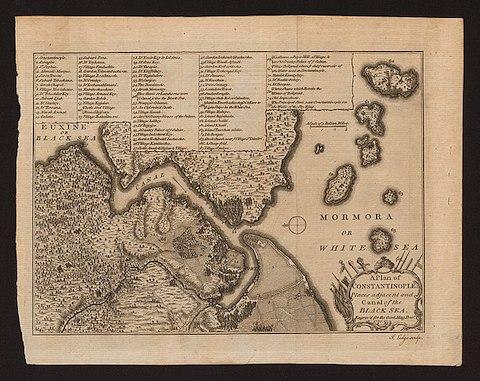
A Plan of Constantinople in 1770 Source: Wikimedia Commons
Located within the Byzantine Empire, the Imperial Library of Constantinople was the last of the libraries of the ancient world. This Library was formed around 357 AD by Constantius II, Byzantine emperor. The Scriptures were transcribed onto parchment from the original papyrus scrolls. A group of librarians and scribes began this process. Historians believe the Library of Constantinople aided in preserving the texts from the Library of Alexandria. As there is little information on the Library itself, there is speculation of a collection of 100,000 manuscripts that were preserved. British scholar Nigel G. Wilson stated, “There is no means of telling how many books the emperor’s library contained. Even if the mediaeval sources gave any figures they would have to be treated with reserve, as numerals are singularly subject to corruption in manuscript tradition, and in addition it is a well-known fact that the majority of people find it impossible to give accurate estimates of large numbers.” (Wilson, op. cit., p.55) Without the Imperial Library of Constantinople, we would never have discovered Classic Greek literature. To this day, remains of the library have not been recovered.
3.) Library of Alexandria
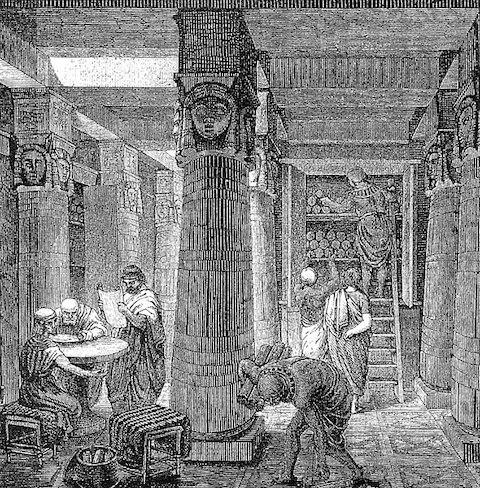
“The Great Library of Alexandria” Source: Wikimedia Commons {{PD-US}}
The Library of Alexandria was located in Alexandria, Egypt. Politician Demetrius of Phaleon founded the Library. The founding date is estimated to be between the years of 285 and 246 BC. After leaving Greece and seeking refuge in Egypt, Demetrius met Ptolemy I Soter. Ptolemy learned of Demetrius’ knowledge thus appointing him to form the Great Library of Alexandria. The Library was affiliated with the Alexandrian Museum which served research purposes of scholars. Historians believe the Library of Alexandria included over 500,000 scrolls made from papyrus. These scrolls included information on legality, science, math, history, and literature. The Rosetta Stone was part of the Library of Alexandria. Works in Egyptian and Greek were available at the Library. The Great Library of Alexandria burned in the midst of war between Ptolemy XIII and Julius Caesar. Now, you can visit the Bibliotheca Alexandrina located in Alexandria, Egypt. Bibliotheca Alexandrina was built in 2002, in memory of the original Library of Alexandria.
4.) Library of Caesarea
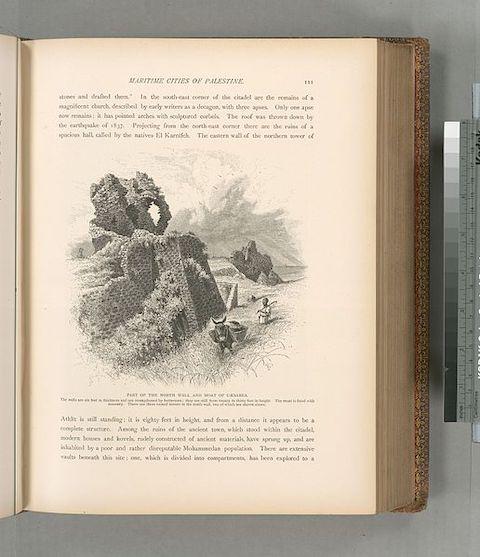
Part of the north wall and moat of Caesarea Source: Wikimedia Commons
{{PD-US}}
Theological Library of Caesarea Maritima, or the Library of Caesarea was located in Israel. Established around the 3rd century, the Theological Library was the epicenter for Christian theologians and philosophers. Ancient city Caesarea, is rich in Biblical history. This is the exact location mentioned in the Book of Acts, where Peter the Apostle baptized Cornelius. Fascinatingly enough, Origen Adamantius’ Hexapla, was part of this Library’s collection. The Hexapla was the fully translated Bible from Hebrew to Greek. The Gospel of the Hebrews was also another profound discovery within the Library of Caesarea.
5.) Royal Library of Antioch
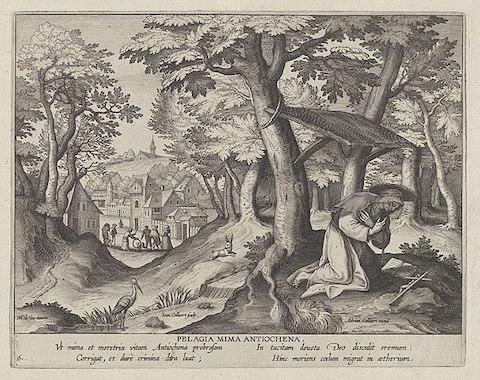
Pelagia of Antioch Source: Wikimedia Commons {{PD-US}}
The Royal Library of Antioch, also referred to as the Library of Antioch, was considered to be, “the most enlightened place in the world.”Antiochus the Great was instrumental in the building process of the library and being in charge of its collections. In 221 BC, Antiochus the Great commissioned a librarian, Euphorion of Chalcis. Euphorion of Chalcis was a Greek poet who assisted with classification of works from Antiochus’ collection and with making Ancient Syria into a city rich in culture, philosophy, and academia. There are no remains left of the collection after its destruction in 363 AD. Emperor Jovia was responsible for this tragedy.
6.) Library of Celsus

Egypt, Sinai, Saint Catherine’s Monastery Source: Wikimedia Commons
The Library of Celsus was formed in around 110 AD and is known to be the last standing library within the Roman Empire. This is the third largest library from the Empire. Located in Ephesus, Anatolia or as we now refer to this region as Selçuk, Turkey, the Library of Celsus was home to over 12,000 scrolls. This library was built as a tribute to Gaius Julius Aquila’s father, Tiberius Julius Celsus Polemaeanus. Tiberius was buried in a sarcophagus underneath the library. Just as most of the libraries described in this list, the Library of Celsus was also burned in a fire. There is speculation that either an earthquake or military exploits were responsible for this destruction. In the 1970’s, archaeologists restored the Library.
7.) Library of Pergamum
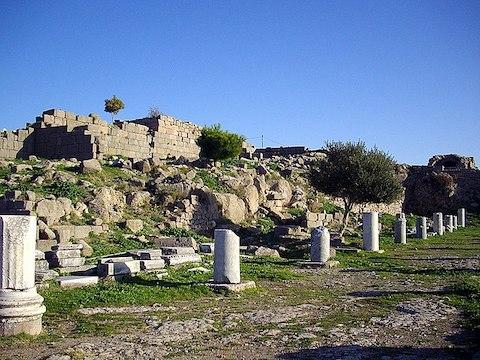
The Acropolis of Pergamum (Pergamon). In the foreground: Columns from the temple of Athena. In the background: Walls and other remains from the Library of Pergamum. Source: Wikimedia Commons
Considered the, “second most important library in the world,” the Library of Pergamum contained over 200,000 volumes. This Library was located in Pergamum, Turkey. This Library’s setup was a precursor to the traditional libraries and how we know them. There was a large reading room amongst the four room layout. The city of Pergamum is of much relevance as described in the New Testament. John of Patmos wrote of Pergamum in the Book of Revelation. The Library of Pergamum was abandoned shortly after the Romans seized control of the Kingdom of Pergamon. As legend has it, Marcus Antonius had taken all of the 200,000 volumes to give to Cleopatra, his wife. Today, you can visit the Library of Pergamum ruins.
8.) House of Wisdom
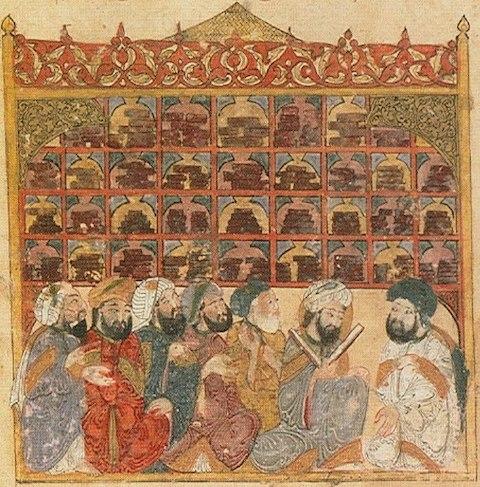
Manuscript with depiction by Yahya ibn Vaseti found in the Maqama of Hariri located at the Bibliotheque Nationale de France. Image depicts a library with pupils in it. Source: Wikimedia Commons {{PD-US}}
Founded in the 8th century, the House of Wisdom also known as the Grand Library of Baghdad, (Iraq), was an immense gateway of knowledge. There is speculation whether the House of Wisdom was created as a private collection or as a public library. Arabic and Persian poetry as well as literature were commonly found here. Rare books were part of this collection. A remarkable fact was the Library’s involvement in the Graeco-Arabic translation movement. Sadly, the Siege of Baghdad was to blame for the destruction of the Grand Library. As there is no proof of this Library’s creation or archaeological discoveries, this poses questions as to the true existence.
9.) Library at Timgad
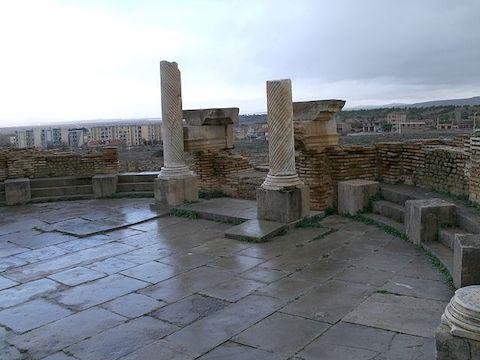
Bibliotheque Timgad Source: Wikimedia Commons
The Library at Timgad, a public library, was a gift to the Romans from Julius Quintianus Flavius Rogatianus. This generous donation was given between the 2nd and 3rd centuries. Information on this philanthropist remains unknown. Timgad, also known as Thamugadi, is located in Algeria. Modern day libraries have adapted to the layout of Timgad. There are sections which mimic a lecture hall, reading area, and book storage rooms. Although uncertain, bookshelves and desks may have been part of this Library. Another uncertainty is the amount of scrolls contained in the Library. There are estimations of having around 3,000 scrolls fit into the Library collection. As we have evidence from the Library of Census, we can conclude the Library at Timgad was the beginning of a completely developed library.
10.) Saint Catherine’s Monastery Library
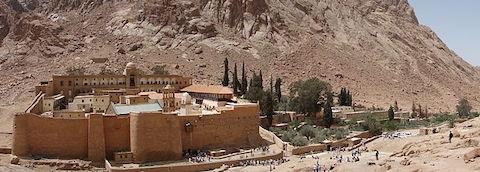
Egypt, Sinai, Saint Catherine’s Monastery Source: Wikimedia Commons
Sinai, Egypt…can you think of what this reminds you of? Were you thinking of Mount Sinai, the Ten Commandments, and Moses? You are correct. While there is not a definite answer, historians believe Mount Sinai to be in the heart of Sinai, Egypt. Sinai is home to Saint Catherine’s Monastery Library. Saint Catherine’s Monastery Library, founded within 6th century AD, is, “considered one of the oldest functioning Christian monasteries in the world.” In the world of Christianity, this library contains immense collections, the second largest to be exact. Within this collection, codices and manuscripts can be found. The oldest translation of the Bible, the Syriac Sinaiticus, as well as the Biblical manuscripts of the New Testament in Greek, Codex Sinaiticus, were home to the Monastery. Various other texts in Arabic and Syriac at Saint Catherine’s were digitized in the 21st century.
There you have it- 10 of the Greatest Libraries of the Ancient World. These magnificent libraries have certainly left a profound impact on our lives. Where would we be without libraries?
Related Reading:
Libraries: Gateway of Knowledge – “Greatest Librarians of Our History”
Links:
- https://www.worldhistory.org/article/1428/libraries-in-the-ancient-world/
- https://www.encyclopedia.com/science/encyclopedias-almanacs-transcripts-and-maps/development-libraries-ancient-world
- https://www.history.com/news/8-impressive-ancient-libraries
- https://blog.britishmuseum.org/a-library-fit-for-a-king/
- https://en.wikipedia.org/wiki/List_of_libraries_in_the_ancient_world
- https://en.wikipedia.org/wiki/Imperial_Library_of_Constantinople
- https://historyofinformation.com/detail.php?entryid=4836
- https://www.yoair.com/blog/the-oldest-libraries-of-the-ancient-world/
- https://www.cambridge.org/core/journals/journal-of-roman-archaeology/article/abs/survey-of-an cient-libraries-casson-lionel-libraries-in-the-ancient-world-yale-university-press-new-haven-ct-2 001-pp-189-30-ills-isbn-0300088094-2295/FA7C00199C3508DA5777ECBE052923FE
- https://owlcation.com/humanities/Five-Libraries-of-the-Ancient-World
- https://www.onlinecollege.org/2011/05/30/11-most-impressive-libraries-from-the-ancient-world/
- https://www.bl.uk/greek-manuscripts/articles/ancient-libraries
- https://greekreporter.com/2021/09/01/library-of-alexandria/
- https://bookriot.com/the-oldest-libraries-in-the-world/
- https://blog.thomascook.in/oldest-libraries-world/
